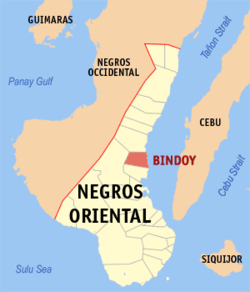Bindoy
| Bindoy | |
|---|---|
| Municipality | |
| Municipality of Bindoy | |
 Map of Negros Oriental with Bindoy highlighted | |
.svg.png) Bindoy Location within the Philippines | |
| Coordinates: 9°46′N 123°08′E / 9.77°N 123.13°ECoordinates: 9°46′N 123°08′E / 9.77°N 123.13°E | |
| Country |
|
| Region | Central Visayas (Region VII) |
| Province | Negros Oriental |
| District | 1st district of Negros Oriental |
| Barangays | 22 (see Barangays) |
| Government [1] | |
| • Type | Sangguniang Bayan |
| • Mayor | Valente D. Yap |
| • Vice Mayor | Eniego Jabagat |
| • Electorate | 22,573 voters (2016) |
| Area [2] | |
| • Total | 173.70 km2 (67.07 sq mi) |
| Population (2015 census)[3] | |
| • Total | 39,819 |
| • Density | 230/km2 (590/sq mi) |
| Time zone | UTC+8 (PST) |
| ZIP code | 6209 |
| PSGC | 074607000 |
| IDD : area code | +63 (0)35 |
| Climate type | Tropical climate |
| Income class | 3rd municipal income class |
| Revenue (₱) | 106,550,968.00 (2016) |
| Native languages |
Cebuano Tagalog |
Bindoy (formerly Payabon), officially the Municipality of Bindoy, is a 3rd class municipality in the province of Negros Oriental, Philippines. According to the 2015 census, it has a population of 39,819 people.[3]
History
Negros Oriental’s lone municipality named after a native of distinction, Bindoy started out as barrio Payabon of Manjuyod. In 1949, President Elpidio Quirino separated it as the Municipality of Bindoy. Hermenegildo “Bindoy” Teves Villanueva (1876-1941) was, at various times, governor of Negros Oriental, congressman of the First District, Labor Secretary of the Quezon cabinet, and senator of the Republic.
Less than two hours’ drive from Dumaguete City, Bindoy is known as the hub of the Negros Oriental I Electric Cooperative, which energizes the northern towns. Its principal produce are copra, rice and corn, sugar cane, mangoes; and quantities of bamboo, pandan and romblon, tikog, buri, maguey and abaca to support cottage industries.
Bindoy’s Bulod flatstones are weighty export items, their quarrying makes for an interesting sight. Bindoy’s mangroves salute nature conservationists, as do dainty Mantahaw Falls and limpid Mantahaw Lake.
The annual Libod-Sayaw sa Bindoy, with streetdancing based on folk dances, is a colorful highlight of the town fiesta.[4]
Barangays
Bindoy is politically subdivided into 22 barangays.
- Atotes
- Batangan
- Bulod
- Cabcaban
- Cabugan
- Camudlas
- Canluto
- Danao
- Danawan
- Domolog
- Malaga
- Manseje
- Matobato
- Nagcasunog
- Nalundan
- Pangalaycayan
- Peñahan
- Poblacion (Payabon)
- Salong
- Tagaytay
- Tinaogan
- Tubod
Demographics
| Population census of Bindoy | ||
|---|---|---|
| Year | Pop. | ±% p.a. |
| 1960 | 13,348 | — |
| 1970 | 18,334 | +3.22% |
| 1975 | 21,121 | +2.88% |
| 1980 | 23,638 | +2.28% |
| 1990 | 29,347 | +2.19% |
| 1995 | 29,472 | +0.08% |
| 2000 | 34,773 | +3.61% |
| 2007 | 36,226 | +0.57% |
| 2010 | 39,416 | +3.12% |
| 2015 | 39,819 | +0.19% |
| Source: Philippine Statistics Authority[3] [5] [6] [7] | ||
See also
References
- ↑ "Municipality". Quezon City, Philippines: Department of the Interior and Local Government. Retrieved 31 May 2013.
- ↑ "Province:". PSGC Interactive. Quezon City, Philippines: Philippine Statistics Authority. Retrieved 12 November 2016.
- 1 2 3 Census of Population (2015). "Region VII (Central Visayas)". Total Population by Province, City, Municipality and Barangay. PSA. Retrieved 20 June 2016.
- ↑ "About | Cities & Towns", Negros Oriental Tourism Office. Retrieved 2013-05-28.
- ↑ Census of Population and Housing (2010). "Region VII (Central Visayas)". Total Population by Province, City, Municipality and Barangay. NSO. Retrieved 29 June 2016.
- ↑ Censuses of Population (1903–2007). "Region VII (Central Visayas)". Table 1. Population Enumerated in Various Censuses by Province/Highly Urbanized City: 1903 to 2007. NSO.
- ↑ "Province of". Municipality Population Data. Local Water Utilities Administration Research Division. Retrieved 17 December 2016.